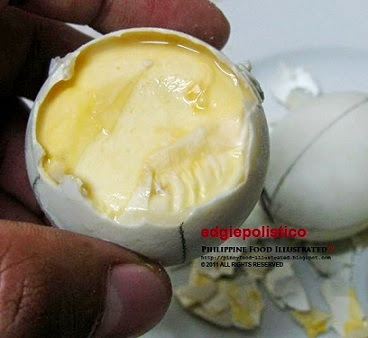a.k.a. balot in Cebuano
balut itlog manok in Tagalog and other local languages
This Visayan delicacy is a new variation of Filipino balut egg that is made with brownish Caber chicken egg. It became popular in Cebu City a few years ago.
This 16-day-old balot itlog manok looks more gruesome than its predecessor duck egg balut. It has more feathers with fully developed legs, head, and beak.

It started to appear in Cebu City sometime in 2012.
Along with the penoy itlog manok or pinoy, this Visayan balot is now gaining fast popularity in Visayas and in some places in Mindanao. It even reached Lucena City in Quezon province and in Bambang, Manila, probably brought and introduced by the Visayans who moved to settle in Quezon province and in Metro Manila.
Recently, I found it on the sidewalk of the Alabang viaduct and on Montillano Street in Muntinlupa City.
This Visayan "balot" is more gruesome compared to its predecessor duck egg balut. It has more hairs (feathers) and the legs, head, and beak of the chick appear to be prominently developed already.
It tastes quite similar to duck egg balut, but the bones are a bit tougher and the hairs are nasty. Next time you dare a foreigner to eat balut, offer this Visayan BALOT instead. Let's see how far we can scare them. hahaha!
By the way, do not dare to offer this to our Muslim brethren because a nasty and gruesome food like this is considered unclean (Haram) according to Islamic laws. Besides, living animals have to be slaughtered in a manner that it has to bleed. Otherwise, you are insulting them.
Related posts:
Penoy

Orange egg barbecue

Pinoy (penoy itlog manok)
For more about Filipino food, see this Philippine Food, Cooking, and Dining Dictionary. It is OPEN and FREE.




























%2Bwatermarked.jpg)




